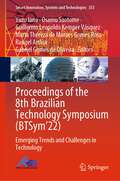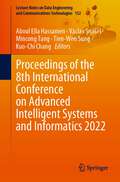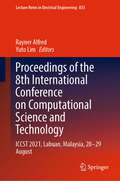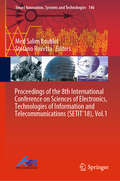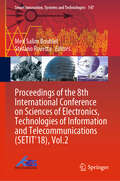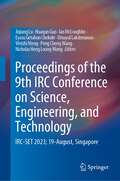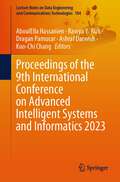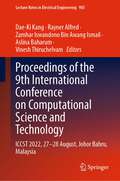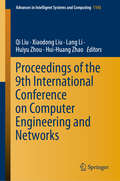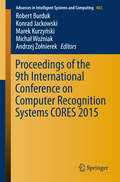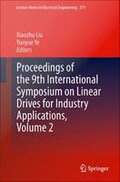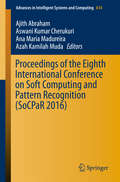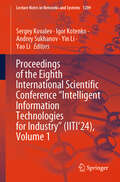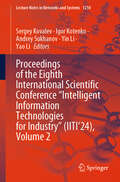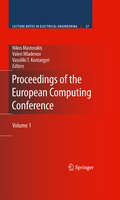- Table View
- List View
Proceedings of the 7th World Congress on Engineering Asset Management (WCEAM #2012)
by Lin Ma Joseph Mathew Woo Bang Lee Byeongkuen ChoiThese proceedings comprise 60 refereed papers of the Seventh World Congress on Engineering Asset Management (WCEAM) that was held in Deajeon City, Korea from 8-9 October 2012. The material is a compilation of state-of-the-art papers in the field covering a comprehensive range of subjects that are equally relevant to business managers and engineering professionals alike. Proceedings of the 7th World Congress on Engineering Asset Management (WCEAM 2012): Towards Integration and Interoperability in EAM covers a wide range of topics in the discipline of engineering asset management, including: · strategic asset management · condition monitoring and diagnostics · integrated intelligent maintenance · sensors and devices · information quality & management; · sustainability in asset management · asset performance and knowledge management · data mining and AI techniques in asset management · engineering standards and · education in engineering asset management. The breadth and depth of these proceedings will make them an excellent resource for asset management practitioners, researchers and academics, as well as undergraduate and postgraduate students in tertiary institutions and in industry.
Proceedings of the 8th Brazilian Technology Symposium: Emerging Trends and Challenges in Technology (Smart Innovation, Systems and Technologies #353)
by Yuzo Iano Rangel Arthur Osamu Saotome Gabriel Gomes de Oliveira Guillermo Leopoldo Kemper Vásquez Maria Thereza de Moraes Gomes RosaThis book presents the proceedings of the 8th Brazilian Technology Symposium (BTSym'22). The book discusses current technological issues on Systems Engineering, Mathematics, and Physical Sciences, such as the Transmission Line, Protein-Modified Mortars, Electromagnetic Properties, Clock Domains, Chebyshev Polynomials, Satellite Control Systems, Hough Transform, Watershed Transform, Blood Smear Images, Toxoplasma Gondi, Operation System Developments, MIMO Systems, Geothermal-Photovoltaic Energy Systems, Mineral Flotation Application, CMOS Techniques, Frameworks Developments, Physiological Parameters Applications, Brain–Computer Interface, Artificial Neural Networks, Computational Vision, Security Applications, FPGA Applications, IoT, Residential Automation, Data Acquisition, Industry 4.0, Cyber-Physical Systems, Digital Image Processing, Patters Recognition, Machine Learning, Photocatalytic Process, Physical-Chemical Analysis, Smoothing Filters, Frequency Synthesizers, Voltage Controlled Ring Oscillator, Difference Amplifier, Photocatalysis, and Photodegradation, and current technological issues on Human, Smart, and Sustainable Future of Cities, such as the Digital Transformation, Data Science, Hydrothermal Dispatch, Project Knowledge Transfer, Immunization Programs, Efficiency and Predictive Methods, PMBOK Applications, Logistics Process, IoT, Data Acquisition, Industry 4.0, Cyber-Physical Systems, Fingerspelling Recognition, Cognitive Ergonomics, Ecosystem Services, Environmental, Ecosystem Services valuation, Solid Waste, and University Extension.
Proceedings of the 8th China High Resolution Earth Observation Conference: High Resolution Earth Observation: Wide Horizon, High Accuracy (Lecture Notes in Electrical Engineering #969)
by Liheng Wang Yirong Wu Jianya GongThis proceedings has four thematic parts: advanced aerospace manufacturing technology, near space system and application technology, accurate perception technology of the earth, and collaborative fusion application technology. The CHREOCs (China High-resolution Earth Observation Conference) focus on the popular topics including military-civilian integration, the One Belt and One Road project, the transformation of scientific research achievements, and it also discusses the new ideas, new technologies, new methods, and new developments. The CHREOCs have effectively promoted high-level institutional mechanisms, technological innovation, and industrial upgrading in the high-resolution earth observation area, and arouse the influence of the national-sponsored major project. All papers in this proceeding are from the 8th CHREOC, and most authors are the researchers and experts participating the state major project CHEOS. The papers are the extraction of research results and reflect the technique level and research direction of the field high-resolution earth observation. All articles have gone through the scientific and strict reviews for several rounds by the experts from the related fields, and therefore reflect the research level and technology innovation of the high-resolution field earth observation. It will be an informative and valuable reference for both academic research and engineering practice. The year 2022 is the final year of high-resolution special projects. After more than ten years of construction, the task of high-resolution special projects has been basically completed, the core technology has been comprehensively breakthrough, and the typical achievements have been rapidly transformed, providing strong support for national security, national defense construction and national economic development.
Proceedings of the 8th International Conference on Advanced Intelligent Systems and Informatics 2022 (Lecture Notes on Data Engineering and Communications Technologies #152)
by Václav Snášel Aboul Ella Hassanien Tien-Wen Sung Kuo-Chi Chang Mincong TangThis proceedings book constitutes the refereed proceedings of the 8th International Conference on Advanced Intelligent Systems and Informatics (AISI 2021), which took place in Cairo, Egypt, during November 20–22, 2022, and is an international interdisciplinary conference that presents a spectrum of scientific research on all aspects of informatics and intelligent systems, technologies, and applications.
Proceedings of the 8th International Conference on Communication and Media 2022 (Advances in Social Science, Education and Humanities Research #769)
by Adibah Ismail Mohd Khairie Ahmad Romlah Ramli Norhayati Mohamad Hussain Syarizan DalibThis is an open access book.We would like to welcome you to the official website of the 8th International Conference on Communication and Media 2022 (i-COME’22). This biennial event is organized by the Department of Communication, School of Multimedia Technology and Communication, Universiti Utara Malaysia and will be held on 1 – 3 October 2022, virtually. The conference provides an opportunity to researchers, practitioners and students to interact and share their experience and knowledge in communication and media. I-COME’22 provides an excellent international platform for knowledge sharing in the areas of communication and media, as well as providing an ideal environment for new collaborations and meeting scholars and experts in the areas of communication and media. I-COME’22 welcomes participants from all over the world who are interested in communication and media, especially how globalization and current situation affects the future landscape of the fields. The aim of the conference is to provide platform for scholars, researchers and practitioners from both academia and industry to meet and share the advanced development and changes in both areas. The conference also hopes to discuss the innovative discovery of research level and promote international scientific cooperation and exchange of ideas among researchers and practitioners. Our conference relies on a wide range of challenges and issues in the fields of communication and media which will be presented through keynote addresses, plenary sessions, presentations by distinguished scholars and practitioners, and doctoral colloquium which is specially designed for post graduate students to share their experiences. The highlight of the conference will be the award presentation during the closing ceremony which will be given as recognition to the outstanding work of the selected researchers.
Proceedings of the 8th International Conference on Computational Science and Technology: ICCST 2021, Labuan, Malaysia, 28–29 August (Lecture Notes in Electrical Engineering #835)
by Rayner Alfred Yuto LimThis book gathers the proceedings of the Seventh International Conference on Computational Science and Technology (ICCST 2021), held in Labuan, Malaysia, on 28–29 August 2021. The respective contributions offer practitioners and researchers a range of new computational techniques and solutions, identify emerging issues, and outline future research directions, while also showing them how to apply the latest large-scale, high-performance computational methods.
Proceedings of the 8th International Conference on Fracture, Fatigue and Wear: FFW 2020, August 26–27 2020 (Lecture Notes in Mechanical Engineering)
by Magd Abdel WahabThis proceedings gather a selection of peer-reviewed papers presented at the 8th International Conference on Fracture Fatigue and Wear (FFW 2020), held as a virtual conference on 26–27 August 2020. The contributions, prepared by international scientists and engineers, cover the latest advances in and innovative applications of fracture mechanics, fatigue of materials, tribology, and wear of materials. In addition, they discuss industrial applications and cover theoretical and analytical methods, numerical simulations and experimental techniques. The book is intended for academics, including graduate students and researchers, as well as industrial practitioners working in the areas of fracture fatigue and wear.
Proceedings of the 8th International Conference on Sciences of Electronics, Technologies of Information and Telecommunications (Smart Innovation, Systems and Technologies #146)
by Stefano Rovetta Med Salim BouhlelThis two-volume book presents an unusually diverse selection of research papers, covering all major topics in the fields of information and communication technologies and related sciences. It provides a wide-angle snapshot of current themes in information and power engineering, pursuing a cross-disciplinary approach to do so. The book gathers revised contributions that were presented at the 2018 International Conference: Sciences of Electronics, Technologies of Information and Telecommunication (SETIT'18), held on 20–22 December 2018 in Hammamet, Tunisia. This eighth installment of the event attracted a wealth of submissions, and the papers presented here were selected by a committee of experts and underwent additional, painstaking revision. Topics covered include:· Information Processing · Human-Machine Interaction · Computer Science · Telecommunications and Networks · Signal Processing · Electronics · Image and Video This broad-scoped approach is becoming increasingly popular in scientific publishing. Its aim is to encourage scholars and professionals to overcome disciplinary barriers, as demanded by current trends in the industry and in the consumer market, which are rapidly leading toward a convergence of data-driven applications, computation, telecommunication, and energy awareness.Given its coverage, the book will benefit graduate students, researchers and practitioners who need to keep up with the latest technological advances.
Proceedings of the 8th International Conference on Sciences of Electronics, Technologies of Information and Telecommunications (Smart Innovation, Systems and Technologies #147)
by Stefano Rovetta Med Salim BouhlelThis two-volume book presents an unusually diverse selection of research papers, covering all major topics in the fields of information and communication technologies and related sciences. It provides a wide-angle snapshot of current themes in information and power engineering, pursuing a cross-disciplinary approach to do so. The book gathers revised contributions that were presented at the 2018 International Conference: Sciences of Electronics, Technologies of Information and Telecommunication (SETIT'18), held on 20–22 December 2018 in Hammamet, Tunisia. This eighth installment of the event attracted a wealth of submissions, and the papers presented here were selected by a committee of experts and underwent additional, painstaking revision. Topics covered include: · Information Processing · Human-Machine Interaction · Computer Science · Telecommunications and Networks · Signal Processing · Electronics · Image and Video This broad-scoped approach is becoming increasingly popular in scientific publishing. Its aim is to encourage scholars and professionals to overcome disciplinary barriers, as demanded by current trends in the industry and in the consumer market, which are rapidly leading toward a convergence of data-driven applications, computation, telecommunication, and energy awareness. Given its coverage, the book will benefit graduate students, researchers and practitioners who need to keep up with the latest technological advances.
Proceedings of the 8th International Ergonomics Conference: ERGONOMICS 2020 (Advances in Intelligent Systems and Computing #1313)
by Davor Sumpor Kristian Jambrošić Tanja Jurčević Lulić Diana Milčić Ivana Salopek Čubrić Irena ŠabarićThis book presents the proceedings of the 8th International Ergonomics Conference (ERGONOMICS), held in Zagreb, Croatia on December 2-5, 2020. By highlighting the latest theories and models, as well as cutting-edge technologies and applications, and by combining findings from a range of disciplines including engineering, design, robotics, healthcare, management, computer science, human biology and behavioral science, it provides researchers and practitioners alike with a comprehensive, timely guide on human factors and ergonomics. It also offers an excellent source of innovative ideas to stimulate future discussions and developments aimed at applying knowledge and techniques to optimize system performance, while at the same time promoting the health, safety and wellbeing of individuals. The proceedings include papers from researchers and practitioners, scientists and physicians, institutional leaders, managers and policy makers that contribute to constructing the Human Factors and Ergonomics approach across a variety of methodologies, domains and productive sectors.
Proceedings of the 9th IRC Conference on Science, Engineering, and Technology: IRC-SET 2023; 19-August, Singapore
by Weizhi Meng Huaqun Guo Eyasu Getahun Chekole Umayal Lakshmanan Ian McLoughlin Peng Cheng Wang Jiqiang Lu Nicholas Heng Loong WongThis book highlights the contemporary state of research in multidisciplinary areas of Computer Science, Computer Engineering, Data Science, Electrical and Electronics Engineering, Chemical Engineering, Mechanical Engineering, Physics, Biomedical Sciences, Life Sciences, Medicine, Healthcare, and Business Technology. The accepted submissions to the 9th IRC Conference on Science, Engineering and Technology (IRC-SET 2023) presented on 19 August 2023 are published in this conference proceedings. The papers presented here were shortlisted after extensive rounds of rigorous reviews by a panel of esteemed individuals who are pioneers and experts in their respective domains.
Proceedings of the 9th International Conference on Advanced Intelligent Systems and Informatics 2023 (Lecture Notes on Data Engineering and Communications Technologies #184)
by Ashraf Darwish Kuo-Chi Chang Dragan Pamucar Rawya Y. Rizk AboulElla HassanienThis proceedings book constitutes the refereed proceedings of the 9th International Conference on Advanced Intelligent Systems and Informatics (AISI 2023), which took place in Port Said University, Port Said, Egypt, during September 20–22, 2023, Egypt, and is an international interdisciplinary conference that presents a spectrum of scientific research on all aspects of informatics and intelligent systems, technologies, and applications.
Proceedings of the 9th International Conference on Computational Science and Technology: ICCST 2022, 27–28 August, Johor Bahru, Malaysia (Lecture Notes in Electrical Engineering #983)
by Rayner Alfred Dae-Ki Kang Zamhar Iswandono Bin Awang Ismail Aslina Baharum Vinesh ThiruchelvamThis book gathers the proceedings of the 9th International Conference on Computational Science and Technology (ICCST 2022), held in Johor Bahru, Malaysia, on August 27–28, 2022. The respective contributions offer practitioners and researchers a range of new computational techniques and solutions, identify emerging issues, and outline future research directions, while also showing them how to apply the latest large-scale, high-performance computational methods.
Proceedings of the 9th International Conference on Computer Engineering and Networks (Advances in Intelligent Systems and Computing #1143)
by Huiyu Zhou Qi Liu Xiaodong Liu Lang Li Hui-Huang ZhaoThis book gathers papers presented at the 9th International Conference on Computer Engineering and Networks (CENet2019), held in Changsha, China, on October 18–20, 2019. It examines innovations in the fields of computer engineering and networking and explores important, state-of-the-art developments in areas such as Information Security, Information Hiding and Cryptography, Cyber Security, and Intelligent Computing and Applications. The book also covers emerging topics in computer engineering and networking, along with their applications, discusses how to improve productivity by using the latest advanced technologies, and examines innovation in the fields of computer engineering and networking, particularly in intelligent computing and security.
Proceedings of the 9th International Conference on Computer Recognition Systems CORES 2015
by Konrad Jackowski Robert Burduk Michał Woźniak Marek Kurzyński Andrzej ŻołnierekThe computer recognition systems are nowadays one of the most promising directions in artificial intelligence. This book is the most comprehensive study of this field. It contains a collection of 79 carefully selected articles contributed by experts of pattern recognition. It reports on current research with respect to both methodology and applications. In particular, it includes the following sections: Features, learning, and classifiers Biometrics Data Stream Classification and Big Data Analytics Image processing and computer vision Medical applications Applications RGB-D perception: recent developments and applications This book is a great reference tool for scientists who deal with the problems of designing computer pattern recognition systems. Its target readers can be the as well researchers as students of computer science, artificial intelligence or robotics.
Proceedings of the 9th International Conference on Fracture, Fatigue and Wear: FFW 2021, August 2–3, Ghent University, Belgium (Lecture Notes in Mechanical Engineering)
by Magd Abdel WahabThis proceedings gather a selection of peer-reviewed papers presented at the 9th International Conference on Fracture Fatigue and Wear (FFW 2021), held in the city of Ghent, Belgium on 2–3 August 2021. The contributions, prepared by international scientists and engineers, cover the latest advances in and innovative applications of fracture mechanics, fatigue of materials, tribology, and wear of materials. In addition, they discuss industrial applications and cover theoretical and analytical methods, numerical simulations and experimental techniques. The book is intended for academics, including graduate students and researchers, as well as industrial practitioners working in the areas of fracture fatigue and wear.
Proceedings of the 9th International Ergonomics Conference: ERGONOMICS 2022 (Lecture Notes in Networks and Systems #701)
by Davor Sumpor Kristian Jambrošić Tanja Jurčević Lulić Ivana Salopek Čubrić Goran ČubrićThis book presents the proceedings of the 9th International Ergonomics Conference (ERGONOMICS), held in Zagreb, Croatia, on December 7–10, 2022. By highlighting the latest theories and models, as well as cutting-edge technologies and applications, and by combining findings from a range of disciplines including engineering, design, robotics, health care, management, computer science, human biology, and behavioral science, it provides researchers and practitioners alike with a comprehensive, timely guide on human factors and ergonomics. It also offers an excellent source of innovative ideas to stimulate future discussions and developments aimed at applying knowledge and techniques to optimize system performance, while at the same time promoting the health, safety, and well-being of individuals. The proceedings includes papers from researchers and practitioners, scientists and physicians, institutional leaders, managers, and policy makers that contribute to constructing the human factors and ergonomics approach across a variety of methodologies, domains, and productive sectors.
Proceedings of the 9th International Symposium on Linear Drives for Industry Applications, Volume 1
by Xiaozhu Liu Yunyue YeThe 9th International Symposium on Linear Drives for Industry Applications (LDIA 2013) was held on July 7-10, 2013 in Hangzhou, China. The LDIA 2013 was organized by Zhejiang University, a leading comprehensive university in China, and offered a venue for leading academic and industrial researchers to exchange their views, ideas and findings on innovative technologies and sustainable solutions leading to linear drivers and intelligence applications. The conference featured keynote speakers, a panel discussion and paper presentations. The objective of the LDIA 2013 is to facilitate the exchange of information on best practices and to profile the latest research advances in the areas of linear drive technologies, control theory, information engineering, control engineering and intelligence applications, which mainly concern the fields of Engineering and Computer Science, Informatics, Communications and Control etc. The proceedings are intended for scientists, engineers and graduate students in Engineering and Computer Science, especially those focusing on linear drives.
Proceedings of the 9th International Symposium on Linear Drives for Industry Applications, Volume 2
by Xiaozhu Liu Yunyue YeThe 9th International Symposium on Linear Drives for Industry Applications (LDIA 2013) was held on July 7-10, 2013 in Hangzhou, China. The LDIA 2013 was organized by Zhejiang University, a leading comprehensive university in China, and offered a venue for leading academic and industrial researchers to exchange their views, ideas and findings on innovative technologies and sustainable solutions leading to linear drivers and intelligence applications. The conference featured keynote speakers, a panel discussion and paper presentations. The objective of the LDIA 2013 is to facilitate the exchange of information on best practices and to profile the latest research advances in the areas of linear drive technologies, control theory, information engineering, control engineering and intelligence applications, which mainly concern the fields of Engineering and Computer Science, Informatics, Communications and Control etc. The proceedings are intended for scientists, engineers and graduate students in Engineering and Computer Science, especially those focusing on linear drives.
Proceedings of the 9th International Symposium on Linear Drives for Industry Applications, Volume 3
by Xiaozhu Liu Yunyue YeThe 9th International Symposium on Linear Drives for Industry Applications (LDIA 2013) was held on July 7-10, 2013 in Hangzhou, China. The LDIA 2013 was organized by Zhejiang University, a leading comprehensive university in China, and offered a venue for leading academic and industrial researchers to exchange their views, ideas and findings on innovative technologies and sustainable solutions leading to linear drivers and intelligence applications. The conference featured keynote speakers, a panel discussion and paper presentations. The objective of the LDIA 2013 is to facilitate the exchange of information on best practices and to profile the latest research advances in the areas of linear drive technologies, control theory, information engineering, control engineering and intelligence applications, which mainly concern the fields of Engineering and Computer Science, Informatics, Communications and Control etc. The proceedings are intended for scientists, engineers and graduate students in Engineering and Computer Science, especially those focusing on linear drives.
Proceedings of the 9th International Symposium on Linear Drives for Industry Applications, Volume 4
by Xiaozhu Liu Yunyue YeThe 9th International Symposium on Linear Drives for Industry Applications (LDIA 2013) was held on July 7-10, 2013 in Hangzhou, China. The LDIA 2013 was organized by Zhejiang University, a leading comprehensive university in China, and offered a venue for leading academic and industrial researchers to exchange their views, ideas and findings on innovative technologies and sustainable solutions leading to linear drivers and intelligence applications. The conference featured keynote speakers, a panel discussion and paper presentations. The objective of the LDIA 2013 is to facilitate the exchange of information on best practices and to profile the latest research advances in the areas of linear drive technologies, control theory, information engineering, control engineering and intelligence applications, which mainly concern the fields of Engineering and Computer Science, Informatics, Communications and Control etc. The proceedings are intended for scientists, engineers and graduate students in Engineering and Computer Science, especially those focusing on linear drives.
Proceedings of the Eighth International Conference on Soft Computing and Pattern Recognition (SoCPaR #2016)
by Ajith Abraham Azah Kamilah Muda Ana Maria Madureira Aswani Kumar CherukuriThis volume presents 70 carefully selected papers from a major joint event: the 8th International Conference on Soft Computing and Pattern Recognition (SoCPaR 2016) and the 8th International Conference on Computational Aspects of Social Networks (CASoN 2016). SoCPaR–CASoN 2016, which was organized by the Machine Intelligence Research Labs (MIR Labs), USA and Vellore Institute of Technology (VIT), India and held at the VIT on December 19–21, 2016. It brings together researchers and practitioners from academia and industry to share their experiences and exchange new ideas on all interdisciplinary areas of soft computing and pattern recognition, as well as intelligent methods applied to social networks.This book is a valuable resource for practicing engineers/scientists and researchers working in the field of soft computing, pattern recognition and social networks.
Proceedings of the Eighth International Scientific Conference “Intelligent Information Technologies for Industry” (Lecture Notes in Networks and Systems #1209)
by Sergey Kovalev Igor Kotenko Andrey Sukhanov Yao Li Yin LiThis book contains the works connected with the key advances in Intelligent Information Technologies for Industry presented at IITI 2024, the Eighth International Scientific Conference on Intelligent Information Technologies for Industry held on November 1–7, 2024, in Harbin, China. The works were written by the experts in the field of applied artificial intelligence including topics such as Machine Learning, Explainable AI, Decision-Making, Fuzzy Logic, Multi-Agent and Bioinspired Systems including their modern applications. The following industrial implementations were touched: railway automation, cyber security, intelligent medical systems, navigation systems. The editors believe that this book will be helpful for all scientists and engineers interested in the modern state of applied artificial intelligence.
Proceedings of the Eighth International Scientific Conference “Intelligent Information Technologies for Industry” (Lecture Notes in Networks and Systems #1210)
by Sergey Kovalev Igor Kotenko Andrey Sukhanov Yao Li Yin LiThis book contains the works connected with the key advances in Intelligent Information Technologies for Industry presented at IITI 2024, the Eighth International Scientific Conference on Intelligent Information Technologies for Industry held on November 1–7, 2024, in Harbin, China. The works were written by the experts in the field of applied artificial intelligence including topics such as Machine Learning, Explainable AI, Decision-Making, Fuzzy Logic, Multi-Agent and Bioinspired Systems including their modern applications. The following industrial implementations were touched: railway automation, cyber security, intelligent medical systems, navigation systems. The editors believe that this book will be helpful for all scientists and engineers interested in the modern state of applied artificial intelligence.
Proceedings of the European Computing Conference: Volume 1
by Nikos Mastorakis Vassiliki T. Kontargyri Valeri MladenovThe European Computing Conference offers a unique forum for establishing new collaborations within present or upcoming research projects, exchanging useful ideas, presenting recent research results, participating in discussions and establishing new academic collaborations, linking university with the industry. Engineers and Scientists working on various areas of Systems Theory, Applied Mathematics, Simulation, Numerical and Computational Methods and Parallel Computing present the latest findings, advances, and current trends on a wide range of topics. This proceedings volume will be of interest to students, researchers, and practicing engineers.

